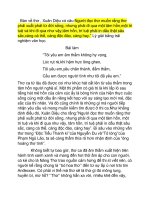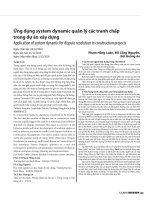Enc of dem in wor rel and cul 164
Bạn đang xem bản rút gọn của tài liệu. Xem và tải ngay bản đầy đủ của tài liệu tại đây (58.67 KB, 1 trang )
free ebooks ==> www.ebook777.com
Hannya
157
TORS OF ASHTAROTH AND ASMODEUS (see
ASHTAROTH and ASMODEUS).
Sources: Ford, Bible of the Adversary, 90; Mathers,
Book of the Sacred Magic of Abramelin the Mage, 116.
Halphas
Variations: Halpas, Malthus, Mathas
Christian demonology ranks Halphas as an earl
and lists him as one of the seventy-two SPIRITS OF
SOLOMON (SEE ALSO EARLS OF HELL and PRESIDENTS OF HELL). Commanding twenty-six legions, this nocturnal demon appears before his
summoner as a stork and speaks with a hoarse
voice. He has the ability to teleport men to battlefields, cause wars, fill towns with soldiers looking
to fight, and is known to stockpile weapons. Destructive, warlike Halphas attacks with a sword
and sets towns ablaze. His zodiacal sign is Libra.
Sources: De Laurence, Lesser Key of Solomon, Goetia,
34; DuQuette, Key to Solomon’s Key, 179–80; Icon,
Demons, 165; Scott, London Magazine, Vol. 5, 378.
Ham
In the Scandinavian Saga Grettir, also known
as The Saga of Grettir the Strong, Ham is a storm
demon in service under Helgi (see AERIAL DEVIL).
He is described as an eagle with black wings.
Sources: De Claremont, Ancients’ Book of Magic, 127;
Spence, Encyclopedia of Occultism, 410.
Hamas
In Theurgia Goetia, the second book of the
Lemegeton, Hamas is ranked as a chief duke and
is listed as one of the sixteen SERVITORS OF
ASYRIEL (see ASYRIEL). A nocturnal demon, he
is good-natured and willing to obey his summoner.
Sources: Belanger, Dictionary of Demons, 152;
Guiley, Encyclopedia of Demons and Demonology, 20;
Peterson, Lesser Key of Solomon, 74.
Hamorphol
In Theurgia Goetia, the second book of the
Lemegeton, Hamorphol is ranked as one of the
eleven named SERVITORS OF PAMERSIEL (see
PAMERSIEL). Ranked as a duke, this nocturnal
AERIAL DEVIL is known to be very useful at driving out spirits from haunted places. He is also an
expert liar and tells secrets. An arrogant and stubborn demon, Hamorphol must be summoned
from the second floor of a home or in a wide open
space.
Sources: Waite, Manual of Cartomancy and Occult
Divination, 97.
Hamou Ukaiou
Hamou Ukaiou is the husband to the DJINN
Aicha Kandida in Moroccan folklore. A
nocturnal demon, he preys upon women who
travel alone at night, stalking and then devouring
them. Sharpening a knife on the ground in his
presence will prevent him from attacking.
Sources: Illes, Encyclopedia of Spirits, 145; Rose, Giants, Monsters, and Dragons, 20.
Hananel
Variations: Anai, ANANEL, Khananel
Hananel (“mercy of God”) is named in the
Book of Enoch as one of the FALLEN ANGELS who
swore allegiance to SAMIAZA, rebelled against
God, took a human wife, and fathered the
NEPHILIM. His name means “glory or grace of
God.”
Sources: Charles, Book of Enoch, 137; Laurence, Foreign Quarterly Review, Vol. 24, 370; Lumpkin, Fallen
Angels, the Watchers, and the Origins of Evil, 31.
Hanbi
Variations: Hanpa
Akkadian and Sumerian mythology names
Hanbi as the Lord of the Evil Wind Demons.
He is the father of the demon PAZUZU.
Sources: Black, Gods, Demons, and Symbols of Ancient
Mesopotamia, 148; Finkel, Sumerian Gods and Their
Representations, 143; Icons, Demons, 171.
Hannya
Variations: Akeru, Hannya-Shin-Kyo (“emptiness of forms”)
A vampiric demon from Japan, the hannya
(“empty”) feeds exclusively off truly beautiful
women and infants. It is described as having a
large chin, long fangs and horns, green scales, a
snakelike forked tongue, and eyes that burn like
twin flames.
Normally, the hannya lives near the sea or
wells, but it is never too far from humans, as it
can sneak unseen into any house that has a potential victim (a sleeping woman) inside. Just before it attacks, the hannya lets loose with a horrible shriek. While the woman is in a state of
being startled, the vampire possesses her, slowly
driving her insane and physically altering her
body into that of a hideous monster. Eventually,
it drives her to attack a child, drink its blood, and
eat its flesh.
There is no known potential weakness to exploit, but there is a Buddhist sutra that renders
humans invisible to spirits and demons. In Japanese No (Noh) theater, young men are depicted
as the favorite victims of an especially vicious and
vindictive hannya.
Sources: Louis-Frédéric, Japan Encyclopedia, 287–
88; Pollack, Reading Against Culture, 50; Toki, Japanese
NÉ Plays, 40








